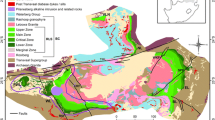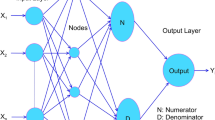Abstract
Use of GIS layers, in which the cell values represent fuzzy membership variables, is an effective method of combining subjective geological knowledge with empirical data in a neural network approach to mineral-prospectivity mapping. In this study, multilayer perceptron (MLP), neural networks are used to combine up to 17 regional exploration variables to predict the potential for orogenic gold deposits in the form of prospectivity maps in the Archean Kalgoorlie Terrane of Western Australia. Two types of fuzzy membership layers are used. In the first type of layer, the statistical relationships between known gold deposits and variables in the GIS thematic layer are used to determine fuzzy membership values. For example, GIS layers depicting solid geology and rock-type combinations of categorical data at the nearest lithological boundary for each cell are converted to fuzzy membership layers representing favorable lithologies and favorable lithological boundaries, respectively. This type of fuzzy-membership input is a useful alternative to the 1-of-N coding used for categorical inputs, particularly if there are a large number of classes. Rheological contrast at lithological boundaries is modeled using a second type of fuzzy membership layer, in which the assignment of fuzzy membership value, although based on geological field data, is subjective. The methods used here could be applied to a large range of subjective data (e.g., favorability of tectonic environment, host stratigraphy, or reactivation along major faults) currently used in regional exploration programs, but which normally would not be included as inputs in an empirical neural network approach.
Similar content being viewed by others
References
An, P., Moon, W. M., and Rencz, A. N. 1991, Application of fuzzy theory for integration of geological, geophysical and remotely sensed data: Can. Jour. Exploration Geophysics, v.27, no.1, p. 1–11.
Bishop, C. M., 1995, Neural networks for pattern recognition: Clarendon Press, Oxford, 482p.
Bonham-Carter, G. F., 1994, Geographic information systems for geoscientists: modelling with GIS, Pergamon Press, New York, 398p.
Brown, W. M., 2002, Artificial neural networks: a new method of mineral prospectivity mapping: unpubl. doctoral dissertation, Univ. Western Australia, Perth, 760p.
Brown, W. M., Gedeon, T. D., Groves, D. I., and Barnes, R. G. 2000, Artificial neural networks: a new method for mineral prospectivity mapping: Australian Jour. Earth Sciences, v.47, no.4, p. 757–770.
Brown, W. M., Baddeley, A., Gedeon, T. D., and Groves, D. I., 2002, Bivariate J-function and other graphical statistical methods help select the best predictor variables as inputs for a neural network method of mineral prospectivity mapping, in Bayer, U., Burger, H., and Skala, W., eds, IAMG 2002: 8th Ann. Conf. Intern. Assoc. Math. Geology (Berlin), v.1, p. 257–268.
Brown, W. M., Taylor, G. R., Jusmady, Groves, D. I., and Knox-Robinson, C. M., 1997, Application of artificial neural networks to prospectivity analysis in a GIS environment: a comparison with statistical and fuzzy logic methods for Au and Sn deposits of the Tenterfield area, NSW (abst.), in 14th Australian Geol. Conv. Abstracts, Geol. Soc. Australia, v.49, p. 57.
Campbell, A. H., Hollister, V. F., and Duda, R. O., 1982, Recognition of a hidden mineral deposit by an artificial intelligence program: Science, v.217, no.4563, p. 927–929.
Carranza, E. J. M., Hale, M., and Mangaoang, J. C., 1999, Application of mineral exploration models and GIS to generate mineral potential maps as input for optimum land-use planning in the Philippines: Natural Resources Research, v.8, no.2, p. 165–173.
Cheng, Q., and Agterberg, F. P., 1999, Fuzzy weights of evidence method and its application in mineral potential mapping: Natural Resources Research, v.8, no.1, p. 27–35.
Clare, A., Bolt, G., and Daniel, G., 1997, The use of neural analysis as an exploration tool, in Proc. Thematic Conf. on Geol. Remote Sensing, v.12, no.2, p. 199–205.
D'Ercole, C., Groves, D. I., and Knox-Robinson, C. M., 2000, Using fuzzy logic in a Geographic Information System environment to enhance conceptually based prospectivity analysis of Mississippi Valley-type mineralisation: Australian Jour. Earth Sciences, v.47, no.5, p. 913–927.
Donaldson, W. S., 1996, The Etheridge goldfield, Queensland: an application of weights of evidence and fuzzy logic in a geographic information system to estimate the probability of gold mineralisation: unpubl. masters dissertation, Uni. New South Wales, Sydney, 92p.
Duda, R. O., Hart, P. E., Barrett, P., Gaschnig, J. C., Konolige, K., Reboh, R., and Slocum, J., 1978, Development of the PROSPECTOR consultation system for mineral exploration: Final Report, Stanford Research Institute International, SRI International, Artificial Intelligence Centre, Menlo Park, California. 193p.
Eddy, B. G., Bonham-Carter, G. F., and Jefferson, C. W., 1995, Mineral resource assessment of the Parry Islands, high Arctic, Canada: a GIS-based fuzzy logic model, in Proc. Can. Conf. on GIS, CD ROM Session C3, Can. Ins. Geomatics, Ottawa, Canada, Paper 4.
Groves, D. I., Ojala, J., and Holyland, P., 1997, Use of geometric parameters of greenstone belts in conceptual exploration for orogenic lode-gold deposits: AGSO Record 1997/41, p. 103–108.
Groves, D. I., Goldfarb, R. J., Knox-Robinson, C., Ojala, J., Gardoll, S., Yun, G., and Holyland, P., 2000, Late-kinematic timing of orogenic gold deposits and significance for computer-based exploration techniques with emphasis on the Yilgarn Block, Western Australia: Ore Geology Reviews, v.17, no.1, p. 1–38.
Groves, D. I., Ridley, J. R., Bloem, E. J. M., Gebre-Mariam, M., Hronsky, J. M. A., Knight, J. T., McCuaig, T. C., McNaughton, N. J. and Ojala, J., 1995, Lode-gold deposits of the Yilgarn Block: products of late-Archaean crustal-scale over-pressured hydrothermal systems, in Coward, R. P., and Ries, A. C., eds, Early Precambrian Processes, Geol. Soc. London, Spec. Publ. 95, p. 152–172.
Gupta, M. M., and Rao, D. H., 1994, On the principles of fuzzy neural networks: Fuzzy Sets and Systems. v.61, no.1, p. 1–18.
Hagan, M. T., and Menhaj, M., 1994, Training feedforward networks with the Marquardt algorithm: IEEE Transactions on Neural Networks, v.5, no.6, p. 989–993.
Harris, D., and Pan, G., 1999, Mineral favorability mapping: a comparison of artificial neural networks, logistic regression, and discriminant analysis: Natural Resources Research, v.8, no.2, p. 93–109.
Hatheway, A. W., and Kiersch, G. A., 1989, Engineering properties of rock, in Carmichael, R. S., ed., CRC Practical handbook of physical properties of rocks and minerals, CRC Press, Boca Raton, 741p.
Holyland, P. W., and Ojala, V. J., 1997, Computer-aided structural targeting in mineral exploration: two and three-dimensional stress mapping: Australian Jour. Earth Sciences, v.44, no.4, p. 421–432.
Huang, Y., Wong, P. M., and Gedeon, T. D., 1996, An improved fuzzy neural network for permeability estimation from wireline logs in a petroleum reservoir: Prec. IEEE Intern. Conf. on Digital signal Processing (TENCON ′96), Los Alamitos, p. 912–917.
Jang, J.-S., and Sun, C.-T., 1995, Neuro-fuzzy modelling and control: Proc. IEEE, v.83, no.3, p. 378–406.
Kasabov, N.K., 1996, Foundations of neural networks, fuzzy logic, and knowledge engineering: MIT Press, Cambridge, 550p.
Katz, S. S., 1991, Emulating the Prospector expert system with a raster GIS: Computers & Geosciences, v.17, no.7, p. 1033–1050.
Knox-Robinson, C. M., 2000, Vectorial fuzzy logic: a novel technique for enhanced mineral prospectivity mapping, with reference to the orogenic gold mineralization potential of the Kalgoorlie Terrane, Western Australia: Australian Jour. Earth Sciences, v.47, no.5, p. 929–942.
Knox-Robinson, C. M., and Wyborn, L. A. I., 1997, Towards a holistic exploration strategy: using Geographic Information Systems as a tool to enhance exploration: Australian Jour. Earth Sciences, v.44, no.4, p. 453–463.
Masters, T., 1993, Practical neural network recipes in C++ Academic Press Inc., San Diego, CA, 493p.
Mikucki, E. J., 1998, Hydrothermal transport and depositional processes in Archean lode-gold systems; a review: Ore Geology Reviews, v.13, no.1, p. 307–321.
Morgan, N., and Bourland, H., 1990, Generalization and parameter estimation in feedforward nets: some experiments, in Touretzsky, D. S., ed., Advances in neural information processing systems (Denver, CO): Morgan Kaufmann, San Mateo, CA, p. 630–637.
Phillips, G. N., and Groves, D. I., 1983, The nature of Archaean gold-bearing fluids as deduced from gold deposits of Western Australia: Jour. Geol. Soc. Australia, v.30, no.1, p. 25–39.
Ridley, J. R., 1993, The relations between mean rock stress and fluid flow in the crust: with reference to vein-and lode-style deposits: Ore Geology Reviews, v.8, no.1, p. 23–37.
Schalkoff, R. J., 1997, Artificial neural networks: McGraw-Hill, Book Co. New York, 422p.
Singer, D. A., and Kouda, R., 1996, Application of a feedfor-ward neural network in the search for Kuroko deposits in the Hokuroku District, Japan: Math. Geology, v.28, no.8, p. 1017–1023.
Singer, D. A., and Kouda, R., 1997a, Use of a neural network to integrate geoscience information in the classification of mineral deposits and occurrences, in Gubins, A.G., ed. Proc. Exploration 97: Fourth Decennial International Conference on Mineral Exploration, p. 127–134.
Singer, D. A., and Kouda, R., 1997b, Classification of mineral deposits into types using mineralogy with a probabilistic neural network: Nonrenewable Resources, v.6, no 1, p. 27–32.
Singer, D. A., and Kouda, R., 1999, A comparison of the weights-of-evidence method and probabilistic neural networks: Natural Resources Research, v.8, no.4, p. 287–298.
Uncini, A. Marchesi, M. Orlandi, G. and Piazza, F. (1990) Improved evoked potential estimation using neural networks. IEEE Conf. Neural Networks, San Diego, CA, p. II 143–148.
Wong, P. M., Gedeon, T. D., Huang, Y., and Shibli, S. A. R., 1998, AI-based multidimensional spatial interpolators: Systems Research and Information Systems, v.8, no.2, p. 81–95.
Woodall, R., 1994, Empiricism and concept in successful mineral exploration: Australian Jour. Earth Sciences, v.41, no.1, p. 1–10.
Wyborn, L. A. I., Gallagher, R., and Raymond, O., 1995, Using GIS for mineral potential evaluation in areas with few known mineral occurrences, in Second National Forum on GIS in the Geosciences-Forum Proc., Australian Geol. Survey Organisation, AGSO Record 1995/46, p. 199–211.
Yang, C., Venkatesh, S. S., and Judd, J. S., 1994, Optimal stopping and effective machine complexity in learning, in Cowan, J. D., Tesauro, G., and Alspector, J., eds., Advances in neural information processing systems (Denver, CO); Morgan Kaufmann, San Francisco, CA, p. 303–310.
Yeats, C. J., and McNaughton, N. J., 1997, Significance of SHRIMP II U-Pb geochronology on lode-gold deposits of the Yilgarn Craton: Australian Geol Survey Organisation, AGSO Record 1997/41, p. 125–130.
Yun, Y. G., 2000, Controls on orogenic (mesothermal) gold deposits: a craton to province scale study within a GIS environment: unpubl. doctoral dissertation, Univ. Western Australia, Perth, 275p.
Zaknich, A., 2003, Neural networks for intelligent signal processing: World Scientific, Singapore, 508p.
Zimmerman, H-J., 1984, Fuzzy set theory and its applications: Kluwer Academic Publishing, Boston, 363p.
Author information
Authors and Affiliations
Rights and permissions
About this article
Cite this article
Brown, W., Groves, D. & Gedeon, T. Use of Fuzzy Membership Input Layers to Combine Subjective Geological Knowledge and Empirical Data in a Neural Network Method for Mineral-Potential Mapping. Natural Resources Research 12, 183–200 (2003). https://doi.org/10.1023/A:1025175904545
Issue Date:
DOI: https://doi.org/10.1023/A:1025175904545




